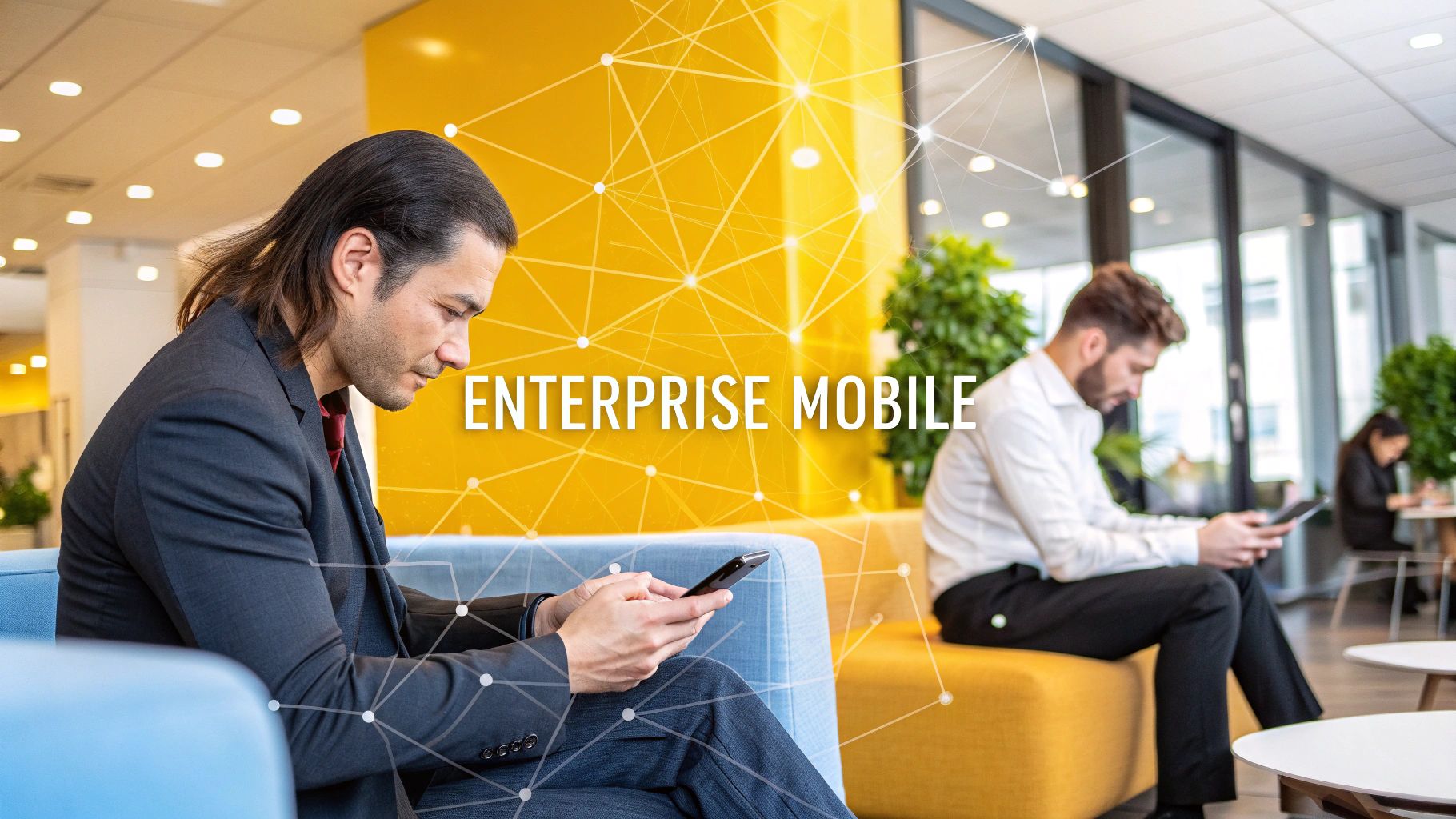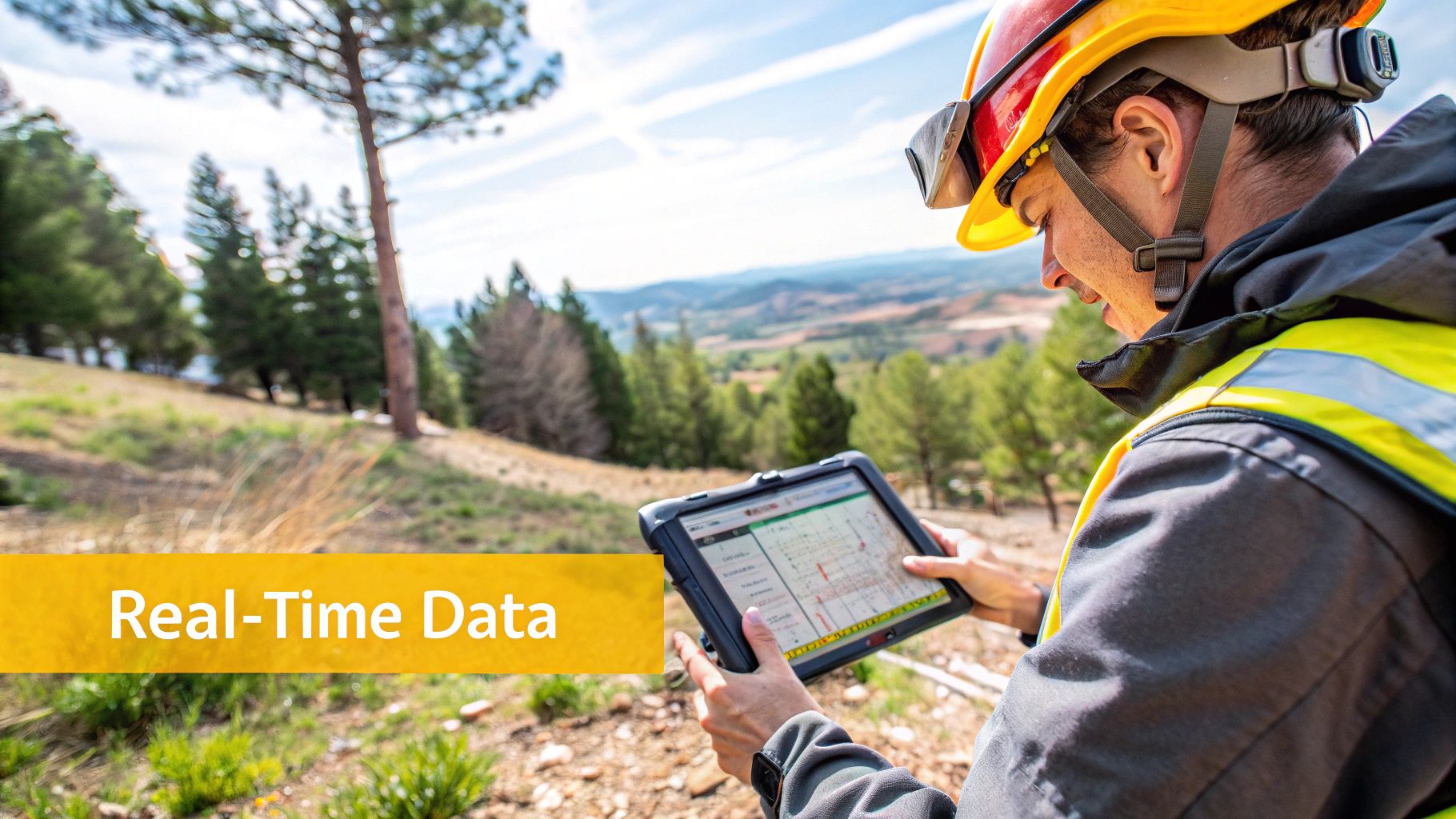Mastering Enterprise Mobile App Development

Enterprise mobile app development is all about creating specialized applications for businesses to solve internal problems, smooth out workflows, and make employees more productive. These aren't the apps you find on the public app store. Instead, they are custom-built tools designed for very specific business needs, requiring serious security, scalability, and integration with the company's existing systems.
What Are Enterprise Mobile Solutions, Really?

Let's break down what truly sets an enterprise app apart from the millions of consumer apps out there. Forget the textbook definitions for a moment.
Think of it this way: a consumer app is like a standard passenger car, built for the general public. An enterprise app, on the other hand, is like a custom-built armored vehicle—engineered for a corporation's specific, high-stakes mission. It needs unique levels of security, the ability to scale, and a way to seamlessly connect with existing operational machinery.
This distinction is key. Building an enterprise mobile app isn't just a technical project; it's a strategic business move to get ahead of the competition. These applications are designed with a crystal-clear purpose: to solve internal pain points and eliminate operational bottlenecks.
The Core Purpose of Enterprise Apps
The main goal is to give employees the tools they need to succeed while refining complicated internal processes. Imagine a sales team pulling up CRM data on the go, a logistics manager tracking shipments from their phone, or an HR specialist handling new hire paperwork through a dedicated app. These tools are the digital gears that keep a company running efficiently.
They are designed to tackle specific, mission-critical business challenges by:
- Empowering Employees: Giving them secure, mobile access to the data and tools they need to do their jobs well, no matter where they are.
- Improving Complex Workflows: Automating tedious tasks, cutting down on manual data entry, and getting rid of paper-based processes.
- Integrating Systems: Acting as a bridge between different software systems—like ERPs, CRMs, and supply chain tools—and bringing them all together in one user-friendly mobile interface.
Investment in these custom mobile solutions is climbing fast. The market for enterprise mobile app development is expected to jump from around $14.98 billion to a massive $303.56 billion by 2030. This growth is fueled by the demand for apps that give teams real-time data access and better ways to communicate. You can discover more insights about this market surge on kumohq.co.
At its heart, enterprise mobile app development is about creating a precision tool that fits perfectly into a company's unique operational puzzle. It’s the opposite of forcing the organization to conform to a generic, off-the-shelf product.
This custom-fit approach ensures the final app becomes an essential part of the business infrastructure, not just another piece of software. The entire enterprise software development process is focused on hitting specific business goals, making it a powerful engine for internal innovation and efficiency. In this guide, we’ll unpack exactly how it all works.
Why Bother With a Custom Enterprise App?

With so many off-the-shelf software options available, building a custom app from scratch might seem like an unnecessary expense. But here's the thing: choosing to build is a strategic move, not just a matter of convenience. It's about creating a tool that fits your business like a glove, giving you a serious competitive edge that generic software just can't.
The real value comes from crafting an app around your company's unique DNA. When the tool is built for your specific processes, you ditch the awkward workarounds and clunky extra steps. This naturally reduces human error and opens the door to productivity gains that a one-size-fits-all solution could never deliver.
Fortified Data Security
Generic software comes with generic security. It has to, because it's built for everyone. A custom enterprise app, on the other hand, lets you build a digital fortress around your company’s sensitive information. Security isn't just a feature you tack on at the end; it's baked into the app's foundation from the very first line of code.
This means you call the shots on security measures, matching them to your industry's specific compliance rules and your own internal risk policies.
- Role-Based Access Control: You can set up incredibly detailed permissions. A sales rep sees only their accounts, while a manager sees the whole team's data. This drastically cuts the risk of internal data leaks.
- Custom Encryption Protocols: You can deploy encryption methods that meet your precise standards, protecting information whether it's sitting on a server or moving between devices.
- Secure API Integrations: When connecting to your existing systems, you build secure, controlled bridges, avoiding the weak points that often come with poorly documented or overly permissive third-party tools.
This level of control is non-negotiable for anyone handling sensitive data. For them, a breach isn't just an inconvenience; it can be a financial and reputational disaster.
A Serious Boost in Employee Productivity
Perhaps the biggest win with a custom app is how it perfectly mirrors the way your employees actually work. You’re not forcing your team to contort their processes to fit a rigid piece of software. Instead, you're building the software to fit them. This simple shift removes a ton of friction and lets people get more done.
Think about a field service team that used to juggle paper forms, clipboards, and constant phone calls back to the office. A custom app could completely change their day.
A technician can get a new job ticket, pull up the right equipment manual, log their completed work, and even take a payment—all from their tablet. If they're in a remote area with no signal, they can keep working offline and the app will sync everything up automatically once they're back online. Productivity never stops.
Not only does this make individual tasks faster, but it also cleans up your data by getting rid of manual entry, which is always a recipe for errors.
Real-Time Data for Smarter Decisions
In today's business world, waiting for yesterday's data is a losing game. Custom enterprise apps create a direct, live link between your people on the ground and the decision-makers back at the office. Every bit of information—from a new sales order logged in the field to an inventory update from the warehouse floor—can be synced instantly with central systems like your ERP or CRM.
This constant flow of information means leaders can make smart, proactive decisions based on what’s happening right now, not what happened last week. For instance, a supply chain manager can watch inventory levels update in real-time as a shipment is unloaded, letting them forecast more accurately and avoid costly stockouts.
At the end of the day, building an enterprise app is about more than just software. It’s about building a smarter, safer, and more efficient organization from the inside out.
Navigating the App Development Lifecycle

Turning a great idea into a fully-realized enterprise app is a journey, not a sprint. The enterprise mobile app development lifecycle isn't some rigid, one-way street. It's a living, breathing process designed for constant improvement and adaptation.
Think of it less like an assembly line and more like building a high-performance race car. Each stage demands careful design, precise engineering, and a ton of testing before it's ready for the track. This methodical approach ensures the final product doesn't just check a few boxes—it aligns perfectly with your business goals and delivers real, measurable value.
Phase 1: Strategic Discovery And Planning
This is where it all begins—the "why" behind the app. Before a single line of code gets written, you have to nail down the app's purpose and make sure it lines up with core business objectives. This isn't just about making a feature wish list; it's about pinpointing the specific problems the app will solve.
Key activities here usually involve:
- Stakeholder Workshops: Getting department heads, IT leaders, and future users in the same room to agree on goals and what success looks like.
- User Research: Talking to the employees who will actually use the app every day. What are their biggest headaches? What would make their jobs easier?
- Competitive Analysis: Looking at existing tools (both inside and outside the company) to find gaps and opportunities to do something better.
The whole point of this phase is to create a solid project roadmap. This document lays out the scope, budget, timeline, and the all-important key performance indicators (KPIs) you'll use to measure success.
Phase 2: Ux/Ui Design And Prototyping
With a clear strategy in hand, the focus shifts to creating the app's blueprint. This phase is all about the user experience (UX) and user interface (UI). UX design maps out the app’s logic and flow, ensuring it feels natural and efficient. UI design then brings that structure to life with a clean, on-brand visual interface.
This is also when we build interactive prototypes and wireframes that simulate the final product. It lets stakeholders and test users actually click through the app and give feedback long before the heavy lifting of coding begins. Finding a design flaw here is exponentially cheaper and faster than fixing it later.
Phase 3: Core Development And Integration
Now the vision starts to become a tangible product. Developers get to work writing the code for both the front-end (what users see) and the back-end (the servers, databases, and application logic that make it all work).
For enterprise apps, one word is king during this stage: integration.
The new application has to securely connect with the systems your business already relies on, such as:
- Customer Relationship Management (CRM) platforms
- Enterprise Resource Planning (ERP) software
- In-house databases and internal APIs
This seamless integration is what prevents the app from becoming just another information silo. It ensures data flows freely across the organization, right where it needs to be.
An app’s true power comes from its ability to connect disparate systems. Without deep integration into core business software, an enterprise app is just a standalone tool with limited impact. True value is unlocked when it acts as a mobile gateway to your entire operational ecosystem.
Phase 4: Rigorous Testing And Quality Assurance
Before any enterprise app sees the light of day, it has to survive a trial by fire. The Quality Assurance (QA) team's job is to throw everything they can at the app to ensure it's stable, secure, and performs under pressure. They run a whole battery of tests to find and squash bugs, patch vulnerabilities, and smooth out performance bottlenecks.
This isn't optional. In the world of enterprise mobile app development, a single critical bug can disrupt business operations or open up a massive security risk.
Phase 5: Deployment And Ongoing Maintenance
Once the app has passed every QA check with flying colors, it’s ready for prime time. Deployment is a carefully managed process, often starting with a pilot launch to a small group of users to gather final feedback before a full company-wide rollout.
But the work doesn't stop at launch. The lifecycle continues with ongoing maintenance and support. This final, crucial phase involves monitoring app performance, fixing any new bugs that pop up, and releasing regular updates. These updates might introduce new features, improve security, or simply keep the app compatible with the latest operating systems.
The table below breaks down these stages, showing how each one contributes to the final product.
Enterprise App Development Lifecycle Stages
| Stage | Key Activities | Primary Objective |
|---|---|---|
| Discovery & Planning | Stakeholder workshops, user research, competitive analysis, roadmap creation. | Align the app's purpose with core business objectives and define success. |
| UX/UI Design | Wireframing, prototyping, user flow mapping, visual interface design. | Create an intuitive, efficient, and visually engaging user experience. |
| Development | Front-end and back-end coding, API development, third-party system integration. | Build a functional, secure, and scalable application based on the design. |
| Testing & QA | Functional, security, performance, and usability testing; bug fixing. | Ensure the app is stable, secure, and ready for a live environment. |
| Deployment & Maintenance | Staged rollouts, performance monitoring, bug fixes, feature updates. | Successfully launch the app and ensure its long-term value and reliability. |
A well-defined maintenance plan ensures the app remains a valuable asset for years to come. For a more detailed look at this entire process, check out our comprehensive guide on the mobile app development lifecycle.
Choosing Your Technology Stack Wisely
Picking the right technology for your enterprise mobile app is one of those foundational decisions that ripples through the entire project. It’s not just a technical detail; it’s a strategic choice that dictates everything from development costs and timelines to how well the app actually performs in the field.
Think of it like building a vehicle. You wouldn't use the same engine and frame for a high-speed delivery drone as you would for a heavy-duty cargo truck. Each has a specific job, and the core components must be chosen to match that purpose.
Get this choice wrong, and you could be looking at sluggish performance, a blown budget, and a nightmare to maintain. But get it right, and you'll have a robust, scalable app that truly serves your business.
When you're ready to build, you'll need to think carefully about choosing a technology stack. This means looking at the key pieces—the front-end (what users see), the back-end (the engine under the hood), and the database (where information lives)—and picking the best tools for each part.
Understanding the Core Development Paths
For enterprise mobile app development, you generally have three main routes you can take. Each comes with its own set of pros and cons, and the best fit really depends on your specific needs, budget, and what you want your users to experience.
Native Development (iOS & Android): This is the top-shelf approach. You build two separate apps from the ground up, one for iOS (using Swift or Objective-C) and one for Android (using Kotlin or Java). The result? The highest performance possible, rock-solid security, and flawless access to device hardware like the camera, GPS, and push notifications. The trade-off is that it’s the most expensive and time-consuming path because you’re managing two distinct codebases.
Cross-Platform Development: This is the efficiency play. You use a single framework like React Native, Flutter, or .NET MAUI to write code once and then deploy it on both iOS and Android. This dramatically reduces development time and costs. Modern cross-platform tools deliver a near-native feel, but you might occasionally run into limitations when you need deep access to specific device features or want to create a highly custom, platform-specific design.
Progressive Web Apps (PWAs): Think of a PWA as a supercharged website that acts like a native app. It runs in a browser but can be "installed" on a user's home screen, send push notifications, and even work offline. The biggest advantage of PWAs is their reach—no app store download is required, and they work on any device with a modern browser. The catch is that their access to native device hardware is more limited than the other two options.
Choosing a path is a classic balancing act. Native gives you peak performance for a premium price. Cross-platform offers a fantastic cost-effective middle ground. And PWAs prioritize easy access and broad reach over everything else.
Matching the Stack to Your Business Goals
The tech stack isn't just about code; it’s the engine that will power your business strategy. To make the right call, you have to connect the technical choices directly to your long-term objectives.
Ask yourself these key questions:
- Who is actually using this app? If it’s for field technicians who need perfect offline mode and deep hardware integration (like a barcode scanner), a native app might be the only real option.
- How fast do we need to get to market? If speed is critical and you need to reach both iOS and Android users quickly, a cross-platform approach is almost always the fastest route.
- How complex are the features? An app that needs heavy-duty graphics processing or slick, complex animations will shine with the raw power of native code.
- What does our long-term maintenance plan look like? Managing a single codebase with a cross-platform framework can make updates and bug fixes much simpler and cheaper down the line compared to juggling two separate native apps.
This kind of strategic thinking helps business leaders have more productive conversations with their technical teams. For a much deeper look into this process, check out our guide on how to choose a technology stack. By really understanding these trade-offs, you can lay a foundation that not only works for your app today but can also grow with your business tomorrow.
Essential Features of a High-Impact Enterprise App

Not all enterprise apps are created equal. The ones that genuinely move the needle for a business share a set of must-have features that go far beyond a polished user interface. These are the foundational pillars that ensure the app is a reliable workhorse, not just a flashy gadget.
Think of it like building a high-performance engine. It’s not just about the shiny exterior; it’s about the precision-engineered components working in perfect harmony. In the same way, the real value of an enterprise app comes from what's under the hood.
Rock-Solid Security Measures
When it comes to enterprise apps, security isn't just a feature—it's the absolute foundation. A single weak point can expose mission-critical data, risking financial disaster and lasting damage to your reputation. This isn't about adding one security tool; it's about building a multi-layered defense.
At a minimum, this means end-to-end data encryption to protect information as it moves and while it's stored. On top of that, multi-factor authentication (MFA) is non-negotiable. It adds a simple but powerful layer of verification that stops most unauthorized access attempts in their tracks.
Built for Scalability
An app that works flawlessly for 50 people can grind to a halt when 5,000 employees try to use it. This is why scalability is critical. Your app needs the architectural backbone to handle a growing number of users, massive amounts of data, and an increasing volume of transactions without slowing down.
An app that cannot scale is an app with a built-in expiration date. True enterprise-grade solutions are architected for future growth, ensuring that today's investment remains valuable for years to come without requiring a complete rebuild.
This means planning from day one for a robust back-end, an efficient database, and often a cloud infrastructure that can automatically scale resources up or down based on demand. Without that foresight, your shiny new app will quickly become a performance bottleneck.
Seamless Systems Integration
A great enterprise app shouldn't be a lonely island of data. Its real power is unlocked when it talks to the other core systems that run your business. It needs to plug in perfectly to your existing software stack, preventing frustrating data silos and manual work.
Key integrations usually fall into a few categories:
- Enterprise Resource Planning (ERP): Connects the app to your supply chain, finance, and operational data.
- Customer Relationship Management (CRM): Gives sales and service teams real-time access to customer information from anywhere.
- Internal Databases and APIs: Allows the app to securely tap into your company's proprietary data and custom-built tools.
This connectivity transforms the app from a simple tool into a central, unified hub for your entire operation.
Essential Offline Functionality
Business doesn’t always happen where there’s a perfect Wi-Fi signal. For field technicians, remote sales teams, or even warehouse staff in a concrete building, offline access is absolutely essential. It allows people to keep working, no matter their connection status.
For instance, a field agent can fill out an inspection form, a salesperson can update meeting notes right after leaving a client's office, and a logistics manager can update inventory deep in a warehouse. As soon as a connection is re-established, the app automatically syncs all the new data back to the central server. This keeps productivity high and ensures no data is lost. A great way to get a feel for this is to look at various mobile UX design examples that master this type of seamless experience.
The Rise of Low-Code and No-Code Platforms
A huge shift is happening in how enterprise mobile apps get built, and it’s all thanks to a new wave of surprisingly accessible tools. Low-code and no-code platforms are changing the entire game, letting teams build and launch applications far faster than was ever possible before.
Think about it this way: traditional coding is like building a house brick by brick. It’s powerful and completely custom, but it demands specialized skills and a whole lot of time. Low-code is more like using prefabricated wall sections—you still need to know how to connect them, but you can put up the structure in a fraction of the time. No-code takes it even further, making the process feel like arranging furniture in a room with a drag-and-drop interface.
This new approach is flinging the doors to app development wide open.
The Emergence of the Citizen Developer
These platforms have paved the way for the “citizen developer.” This isn't a professional coder, but someone like a business analyst or project manager who deeply understands a business problem and can now build a functional app to fix it, often without writing a single line of code.
Imagine an HR department creating its own app to track employee onboarding, or a marketing team quickly spinning up a tool to manage event logistics. They no longer have to get in line and wait for the central IT team to free up. They can solve their own problems, right now.
Low-code and no-code tools are essentially democratizing development. They shift the power to create from a small group of specialists to the business users who are actually closest to the problem, which is a massive boost for both innovation and agility.
The numbers back this up. Industry forecasts show that by 2025, a staggering 70% of new enterprise mobile applications will be built using low-code or no-code technologies. That’s a giant leap from less than 25% back in 2020, and it proves just how urgent the need is to build apps faster and get around the chronic shortage of developers. You can explore the full research on this market shift at mordorintelligence.com for a deeper dive.
Knowing the Limitations
For all their speed and accessibility, these platforms aren't a silver bullet. It's crucial to understand the trade-offs before you jump in.
- Customization Constraints: If you need a truly unique feature or a highly complex user interface, you'll likely hit a wall with drag-and-drop builders.
- Integration Challenges: Getting these apps to talk to older, legacy enterprise systems or very specific third-party APIs can sometimes be a major headache.
- Scalability Concerns: An app that works great for one department might buckle under the pressure of massive user loads or the kind of heavy-duty data processing a global enterprise demands.
At the end of the day, it’s all about picking the right tool for the job. For building internal tools to solve a specific team's problem or for rapidly prototyping an idea, low-code and no-code platforms are fantastic. But for your mission-critical, highly secure, or massively complex applications, the raw power and flexibility of traditional custom coding is still king.
Frequently Asked Questions
When you're diving into enterprise mobile app development, you're bound to have some big questions about money, time, and what makes these apps tick. Getting straight answers is the first step toward a successful project. Let's tackle the questions we hear the most.
How Much Does Enterprise App Development Cost?
The price tag on an enterprise app can swing dramatically, usually landing somewhere between $50,000 and $500,000, and sometimes even more. What causes such a huge range? It really boils down to a few key things.
The complexity of the features you need, how many existing systems it has to talk to (like your SAP ERP or Salesforce CRM), and the tech you build it with all play a major role. A simple internal app for company news will be on the lower end, but a sophisticated supply chain management tool with real-time data and heavy security requirements will naturally push the budget much higher.
How Long Does It Take to Build an Enterprise App?
You can generally expect the process to take anywhere from 4 to 9 months. For exceptionally complex projects, it's not unheard of for development to stretch beyond a year. This timeline isn't just one long slog; it's broken down into several distinct stages.
Here’s a rough breakdown of how that time is spent:
- Strategy and Discovery: 1-2 months
- UX/UI Design and Prototyping: 1-2 months
- Development and Integration: 3-6+ months
- Testing and Deployment: 1 month
Of course, the final timeline depends on the project's size, how big your development team is, and how quickly your own team can provide feedback and make decisions.
The core difference lies in purpose and audience. Consumer apps are built for the public, focusing on user acquisition. Enterprise apps are precision tools for employees or partners, prioritizing security, system integration, and solving specific operational problems.
What Is the Main Difference Between Enterprise and Consumer Apps?
While they both end up on a smartphone, an enterprise app and a consumer app are two completely different animals. Consumer apps, like the ones you use for social media or gaming, are built for the public. Their success is all about downloads, active users, and keeping a broad audience engaged.
Enterprise apps, on the other hand, are custom-built for a select group of people—your employees or business partners. The goal isn't to top the app store charts; it's to solve a specific business problem, make a workflow more efficient, or securely connect people to internal data. That's why the focus is squarely on iron-clad security, seamless integration with your existing systems, and the ability to scale as your business grows.